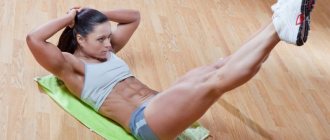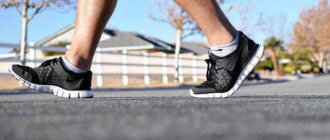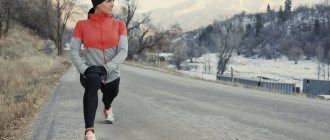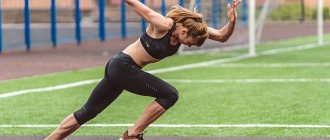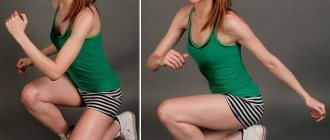"Body armor." This is the name that the now famous “heroic” WOD “Murph” originally had. This complex is named after US Navy Lieutenant Michael Murphy, who died on June 28, 2005, after he exposed himself to enemy fire by deliberately leaving a safe position in order to pick up a signal to communicate with headquarters.
He managed to transmit his coordinates and call for help, but later, returning to defensive positions, he died from his wounds, continuing to fight despite multiple wounds. I could write an entire article about Lt. Murphy's heroism and how his personal courage and that of his unit's members inspires the CrossFit community today, but that's for another time.
The reason I thought of the Bulletproof Vest was because it was invented by Lieutenant Murphy, and he preferred to do a 1-mile run, 100 pull-ups, 200 push-ups, and 300 sit-ups (and then 1 more). mile) while wearing a 25-pound vest. When CrossFit gyms do the Memorial Day Murph, athletes have the choice of whether or not to wear a weight vest. Recommended vest weight is 20 lbs.
You may have already glanced at the black vest hanging on the equipment rack in the gym and thought, “Damn, that looks cool! But I know that training in such a vest will be really tough. Am I ready for this? And what will using a vest give me?
Weighted vests for running
Weights for running - vests are used mainly by winter sports athletes - skiing, hockey, speed skating and short track speed skating, that is, where there is a sliding movement and there is no hard impact of the foot on the ground. On ice and ski tracks you can push yourself more than in cross-country training in the summer. For running in sneakers, it is advisable to reduce the weight of the vest to 5–10 kg and try to run on your toes.
Weighted vests for running should be worn like vests. Weights that are worn over the head like “armor armor” are not suitable for running. In these models, the weight of the weights lies on the chest and the vest is secured with straps on the athlete’s chest. Don't tighten it too tight - you won't be able to breathe. When running, such a vest will “jump”, which will discourage any desire to exercise in it.
The girth of the chest is wider than the waist, and in order for the vest not to “jump”, it must be secured to the body below the chest. When running in a weighted vest, the athlete must breathe freely.
For speed training, we produce vests with adjustable size and weight “Stayer”, “Sprinter” and “Profi”. The “Stayer” and “Sprinter” weights are convenient for athletes of short stature and light weight categories. These are short vests with loads arranged in one row. Tall athletes will be more comfortable running in “Pro” weights, in which the vests are tightened along the body at the waist with lower straps. For example: “Profi” vests 12 and 15 kg are used in professional hockey clubs for training on ice. Put on for protection. For physical For training in the gym or on the street, the vests are easily adjusted to a smaller size.
Gwyneth Paltrow Lesson Plan
The system of the famous trainer Tracy Anderson, whose clients also included Madonna, Nicole Richie, and Shakira, helps the actress keep in shape. Gwyneth Paltrow has been practicing her method for more than 10 years and is so inspired by it that she involves Tracy in many of her projects - filming workouts, classes in her own fitness club, etc.
The actress herself trains 5 times a week for an hour or two a day. Each lesson consists of an intensive dance lesson, a set of strength exercises (to target specific areas) and Pilates exercises. To ensure that the actress does not get bored with her workouts and continues to bring results, Tracy Anderson adjusts her exercise program weekly.
One of Gwyneth’s favorite routines is working with hand weights.
Comment by Pavla Fedorova , personal trainer, group program instructor at Fitlab studio: “This is an interesting complex, it is based on a lot of hand movements, borrowed from different dance styles. All of them, however, help to a greater extent to work out the muscles of the shoulder region, but the muscles of the arms are not properly used. In terms of the degree of load and effectiveness, training in this version is suitable for those who have recently started working out or, say, do not like exercises with dumbbells.”
We asked our expert to adapt Gwyneth Paltrow's workout so that the complex would also work the arm muscles.
Ankle weights
For running, we produce leg weights with adjustable weights of 150 and 250 grams.
The maximum weight of leg weights for running should not exceed 2 kg. Over 2 kg on each leg, the gait changes and running with heavier weights becomes dangerous. Many athletes think that if they buy leg weights of 3.5 or 5 kg, and disassemble them for running to 1 - 2 kg, they will save money, that is, they will wind crosses and swing in the same cuffs. This is a wrong opinion, since heavy cuffs with larger loads are used only for weight-bearing exercises, and if you leave even 1 or 2 weights in them, then when running they will cramp your legs. Buy 1.5 - 2 kg leg weights for jogging and you will be satisfied.
Benefits of training with a weight vest
About the benefits of using vests with additional weights in CrossFit. WodLoft gives advice.
"Body armor." This is the name that the now famous “heroic” WOD “Murph” originally had. This complex is named after US Navy Lieutenant Michael Murphy, who died on June 28, 2005, after he exposed himself to enemy fire by deliberately leaving a safe position in order to pick up a signal to communicate with headquarters. He managed to transmit his coordinates and call for help, but later, returning to defensive positions, he died from his wounds, continuing to fight despite multiple wounds. I could write an entire article about Lt. Murphy's heroism and how his personal courage and that of his unit's members inspires the CrossFit community today, but that's for another time. The reason I thought of the Bulletproof Vest was because it was invented by Lieutenant Murphy, and he preferred to do a 1-mile run, 100 pull-ups, 200 push-ups, and 300 sit-ups (and then 1 more). mile) while wearing a 25-pound vest. When CrossFit gyms do the Memorial Day Murph, athletes have the choice of whether or not to wear a weight vest. Recommended vest weight is 20 lbs.
You may have already glanced at the black vest hanging on the equipment rack in the gym and thought, “Damn, that looks cool! But I know that training in such a vest will be really tough. Am I ready for this? And what will using a vest give me?
Just in case you haven't been warned yet, the weight vest is named that way because it's really heavy. These vests are worn over the upper body and can provide varying levels of resistance due to the fact that many allow you to add and remove additional weights. Because of this flexibility, weight vests can be used in a wide range of exercises, such as jogging, rope climbing, pull-ups, push-ups, abdominal exercises, burpees (yes, baby!) and many more.
So if you decide to strap on one of these hellish machines and go through any kind of WOD, there are a few things you should know.
Before you decide to try a Rambo level WOD, think carefully about your fitness level, as it will have a direct bearing on the type of WODs you do regularly in CrossFit. Are most movements easy for you and do you often have to lower the difficulty level of the program? Do you have to rest on the days after training? How difficult is it for you to meet the allotted time for completing the WOD? Do you only work out once or twice a week? If the answer to any of the above questions is yes, then you should rather pay attention to your general fitness level before using additional weights. If you've already done this, you can test your capabilities by wearing a lightweight vest for some endurance training that involves a lot of running or other cardiovascular work. This is a good place to start.
The intensity, duration, and list of exercises vary from workout to workout, and this will influence whether you should wear a weight vest. For example, if you're doing heavy EMOM cleans, I don't think you should complicate the whole routine by wearing extra weight. In addition, if you want to focus on your technique, body position, bar trajectory, then most likely the vest will not allow you to do this. On the other hand, if you want to honor the memory of a loved one, or a fallen member of the military or first responders, then I think wearing a vest is a great way to do it. Many of us can only imagine all the hardships that these guys and girls endured as a result of their work - putting on a weight vest should be an effective reminder of this fact for us, and then only to a small extent. In addition, you may notice that some of the WODs in your training program come too easily to you and you do them faster and faster as your level of physical development increases. It might be worth stepping back for a while and trying to evaluate what your body is capable of if you put an extra 20 pounds on you. Just make sure you check with your coach before you start torturing yourself.
It is important. If you're looking to add variety to your metabolic endurance training, even a 5-pound weight will be enough to push you to push yourself harder. But remember that even 5 pounds changes the entire training process and your body may not be ready for it - especially if you're wearing a vest for the first time. If you choose to wear a vest to perform the Murph, each step will be heavier as you run, which will add stress to your knees and joints.
The positive effect of using a weight vest is noticeable both during strength training and when performing aerobic exercises. Carrying extra weight while performing exercise requires using more force and more oxygen, while at the same time depleting your energy reserves. In any exercise, the more weight used, the more the muscles have to adapt to the heavy weight, which develops strength and muscular endurance.
Texas Tech University conducted a study by observing a group of guys from a local American football team. Some of them did traditional weight training and plyometric training (aimed at developing explosive strength), while the second group did the same, but in special vests with additional weight. After 6 weeks, it was observed that both groups improved their performance in the 40-yard sprint (36.5 meters), long jump, and high jump, but at the same time, the group that trained in weight vests showed significantly better results.
“Constantly varying, functional exercises performed at high intensity.” I'm sure you've heard this phrase many times and think of it as the definition of CrossFit. The human body adapts to specific movements over time, for better or worse. Stalled progress in performing exercises is usually the result of such adaptation. A weight vest is a great tool for creating exercise variations that our bodies aren't ready for. This unconventional method allows us to break the established training system when needed.
While having similar effects on muscle strength and endurance, running or rowing with a weight vest can be a lot more challenging than you might imagine. The cardiovascular system goes into overdrive due to the extra weight, which leads to stronger lungs and an increase in VO2 Max (a measure of the body's ability to consume oxygen), as well as a decrease in the lactate threshold (the threshold after which, after crossing, intense exercise, lactic acid begins to accumulate in the blood). This is exactly what is shown in studies published in the European Journal of Applied Physiology and Occupational Physiology. A group of athletes for whom endurance is extremely important was divided into experimental (trained in vests) and control subgroups to study the effect of using additional weight during training on energy metabolism. Research has shown that “a group of subjects who used extra weight during each workout had a 2 mmol (millimol) lower lactate threshold, better run times to exhaustion, faster speeds on vertical stair runs, and increased VO2 on runs after. additional load cycle."
In addition to strengthening your muscles, wearing a weight vest during a race also increases the transfer of load through your bones. The extra stress can cause bone mass to increase by stimulating cells called osteoblasts (bone cells). They will create new bone material in response to your body's need to strengthen your skeleton. Simply put, your bones will become stronger and denser to support more weight.
A weight vest is not a cheap item, and if your gym doesn’t have them or there are too few of them, then be prepared to shell out more than 3,000 rubles apiece, and this does not include additional plates if you need them. It's also worth keeping an eye on the weight you use, as too much load can have the opposite, negative effect on your running technique. If the vest is too heavy, you may find yourself running using lower or shorter strides, which will subsequently affect your running form when you return to running without the extra weight. This means you won't be able to run faster or further. And to top it off, wearing a vest that is too heavy will put more stress on your joints, which can lead to injury. Make sure you start with light weights (no more than 5% of your body weight) to minimize the risk of injury, and work your way up from there.
A weighted vest can make common exercises—for example, pull-ups, push-ups, running—more effective. It is usually used by trained athletes who need more severe loads than their own body weight.
Despite the “heavy” name, using a weighted vest is very easy. Just pour the sand into the special bags (up to 18 kg) that come with the kit and put them in the large pockets of the vest. Then secure the weighted vest to your body with two waist straps.
You can independently adjust the weight of the vest by changing the amount of sand (or other filler) in the bags. Filler is not included. You can buy a weighted vest with a 1-year warranty online.
Source https://wodloft.ru
Running weights "Drive"
Universal “Drive” weights are used for running with weights on the legs and the ability to be used on the waist as a weight belt.
Extended cuff straps with additional wide Velcro sewn onto them allow you to put weights on your legs for running at any time of the year. In winter, the leg circumference of a thick sock or high-top sports sneakers increases by 5-10 cm. The length of the strap of conventional weights for fastening to the legs may not be enough. But there is a way out - universal “Drive” weights are worn on the feet with a tight fit, both on thin toes and on any winter shoes - hockey boots, mountain boots or ankle boots.
Selected according to leg and waist circumference.
Hand weights
For running, the weight of weights on your arms is not important.
Load up as much as you have the strength and health, but only enough to run or walk back. The fact is that when running with weighted arms, all the muscles of the body are involved in the work - from the neck to the feet. It's hard. For example, in professional sports, players use hand cuffs weighing up to 1 kg on each hand. In boxing for shadow boxing 3x3 weights, gloves up to 2 kg are used. Running with 2.5 kg weights on your arms for 5 km puts a much greater load on the body than wearing a 12 kg vest for the same distance.
Calculate your weight wisely and train for health!
Pros and cons of using weights
It is recommended to use weights only when absolutely necessary. If you run for yourself, use this type of running only for variety. Constantly running with extra weight is detrimental to your knees and spine.
After a while, your knees will begin to hurt after running, and then for no apparent reason. Under such conditions, a trip to the doctor is guaranteed. If the goal is to increase leg muscles or give relief, it is better to turn to other exercises at home or in the gym.
An alternative to weights can be a parachute, which takes the load off the musculoskeletal system, but creates resistance.
However, weights also have benefits, otherwise they would not have been invented. Additional exercise allows you to speed up fat burning. This type of training has a shorter duration with the same effect. Therefore, if you do not have time for long runs or simply do not want to spend a lot of time, this option is especially for you.
